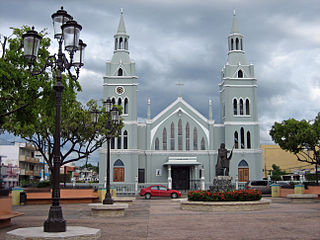 W
WAguada, originally San Francisco de Asís de la Aguada, is a town and municipality of Puerto Rico, located in the western coastal valley region bordering the Atlantic Ocean, east of Rincón, west of Aguadilla and Moca; and north of Añasco and Mayagüez. It is part of the Aguadilla-Isabela-San Sebastián Metropolitan Statistical Area. Aguada's population is spread over 17 barrios and Aguada Pueblo.
 W
WThe Basílica of the Virgin of Monserrat is a historical Marian shrine built in the town of Hormigueros, Puerto Rico dedicated to the Blessed Virgin Mary under the honorific title of “Virgin of Montserrat”.
 W
WCalafia, or Califia, is the fictional queen of the island of California, first introduced by sixteenth-century poet Garci Rodríguez de Montalvo in his epic novel of chivalry, Las sergas de Esplandián, written around 1510. The Californias, a region of North America encompassing the U.S. state of California and the Mexican states of Baja California and Baja California Sur, take their name from Calafia and her kingdom.
 W
WChanekeh, Chaneque or Ohuican Chaneque, as they were called by the Aztecs, are legendary creatures in Mexican folklore. In Náhuatl, chaneque means "those who inhabit dangerous places" or the "owners of the house". They are conceived of as small, sprite-like beings, elemental forces and guardians of nature. Similar mythical beings are common in Mesoamerican and other Latin American folkloric traditions, generally referred to in Spanish as duende. In the folkloric tradition of the Yucatán Peninsula, these elementals are known by their Yucatec Mayan name aluxob.
 W
WRegarded as the last successful pirate of the Caribbean during the 19th century's suppression era, the life of Roberto Cofresí has been romanticized in his native Puerto Rico and neighboring nations. Already possessing a reputation as hard to capture in life, the freebooter became a symbol for an archipelago immersed in the political unrest caused by its status as a colony within the struggling Spanish Empire. Under these circumstances, Cofresí was soon characterized as a benign and generous thief. In a similar trend, he was also associated with the Puerto Rican independence movement of the era. During the late 19th and early 20th century, the abundant oral tradition led to a subgenre of folk hero literature which depicted Cofresí as a benevolent force and contradicted the other pirate-related works of the time, including the well known Treasure Island and Peter Pan. A century later, this contrast became the subject of sociological study. Research to uncover the historical figure behind these myths has also been published by authors linked to the Puerto Rican Genealogical Society, which creates a parallel to this narrative.
 W
WColombian folklore are beliefs, customs and cultural traditions in Colombia.
 W
WCostumbrismo is the literary or pictorial interpretation of local everyday life, mannerisms, and customs, primarily in the Hispanic scene, and particularly in the 19th century. Costumbrismo is related both to artistic realism and to Romanticism, sharing the Romantic interest in expression as against simple representation and the romantic and realist focus on precise representation of particular times and places, rather than of humanity in the abstract. It is often satiric and even moralizing, but unlike mainstream realism does not usually offer or even imply any particular analysis of the society it depicts. When not satiric, its approach to quaint folkloric detail often has a romanticizing aspect.
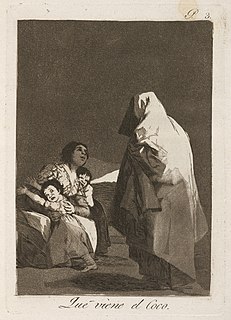 W
WThe Coco or Coca is a mythical ghost-monster, equivalent to the bogeyman, found in many Hispanic or Spanish speaking countries. It can also be considered an Iberian version of a bugbear as it is a commonly used figure of speech representing an irrational or exaggerated fear. The Cucuy is a male being while Cuca is a female version of the mythical monster. The "monster" will come to the house of disobedient children and make them "disappear".
 W
WA curandero is a traditional native healer/shaman found in Latin America, the United States and Southern Europe. The curandero's life is dedicated to the administration of remedies for mental, emotional, physical and spiritual illnesses. The role of a curandero can also incorporate the roles of psychiatrists along with that of physicians and "healers". Some curanderos, such as Don Pedrito, the Healer of Los Olmos, make use of simple herbs, waters, and even mud to effect their cures. Others add Catholic elements, such as holy water and pictures of saints. The use of Catholic prayers and other borrowings and lendings is often found alongside native religious elements. Still others, such as Maria Sabina, employ hallucinogenic media. Many curanderos emphasize their native spirituality in healing while being practicing Catholics.
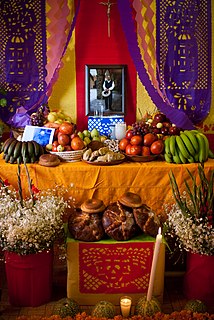 W
WThe Day of the Dead is a holiday celebrated from 31st October through 2nd of November inclusive, though other days, such as 6th November, may be included depending on the locality. It originated, in part, in Mexico, where it is mostly observed, but also in other places, especially by people of Mexican heritage elsewhere. Although associated with the Western Christian Allhallowtide observances of All Hallow's Eve, All Saints' Day and All Souls' Day, it has a much less solemn tone and is portrayed as a holiday of joyful celebration rather than mourning. The multi-day holiday involves family and friends gathering to pay respects and to remember friends and family members who have died. These celebrations can take a humorous tone, as celebrants remember funny events and anecdotes about the departed.
 W
WDogs have occupied a powerful place in Mesoamerican folklore and myth since at least the Classic Period right through to modern times. A common belief across the Mesoamerican region is that a dog carries the newly deceased across a body of water in the afterlife. Dogs appear in underworld scenes painted on Maya pottery dating to the Classic Period and even earlier than this, in the Preclassic, the people of Chupícuaro buried dogs with the dead. In the great Classic Period metropolis of Teotihuacan, 14 human bodies were deposited in a cave, most of them children, together with the bodies of three dogs to guide them on their path to the underworld.
 W
WA duende is a humanoid figure of folklore, with variations from Iberian, Ibero American, and Filipino cultures, comparable to dwarves, gnomes, or leprechauns. In Spanish duende originated as a contraction of the phrase dueño de casa or duen de casa, effectively "master of the house", or perhaps derived from some similar mythical being of the Visigoth or Swabian culture given its similarity with the “Tomte” of the Swedish language conceptualized as a mischievous spirit inhabiting a dwelling.
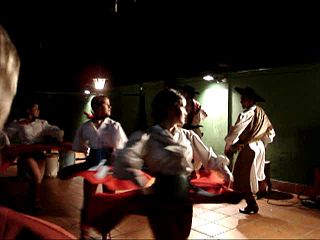 W
WThe gato is a style of Argentine music and Uruguayan music and the associated dance. It is a very popular folk dance in the country. Its rhythm is like the chacarera, but its structure is different. Usually, the lyrics of gatos are picaresque or humorous. This dance can be attributed to the Spanish Armada of Philip II, who was once defeated by Queen Elizabeth I of England.
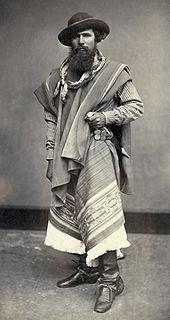 W
WA gaucho or gaúcho is a skilled horseman, reputed to be brave and unruly. The figure of the gaucho is a folk symbol of Argentina, Uruguay, Rio Grande do Sul in Brazil, and the south of Chilean Patagonia. Gauchos became greatly admired and renowned in legend, folklore, and literature and became an important part of their regional cultural tradition. Beginning late in the 19th century, after the heyday of the gauchos, they were celebrated by South American writers.
 W
WGonzalo Guerrero was a sailor from Palos, in Spain who was shipwrecked along the Yucatán Peninsula and was taken as a slave by the local Maya. Earning his freedom, Guerrero became a respected warrior under a Maya lord and raised three of the first mestizo children in Mexico and presumably the first mixed children of the mainland Americas. Little is known of his early life.
 W
WHormigueros is a town and municipality of Puerto Rico located in the western region of the island, northeast of Cabo Rojo; northwest of San Germán; and south of Mayagüez. Hormigueros is spread over 5 barrios and Hormigueros Pueblo. It is part of the Mayagüez Metropolitan Statistical Area.
 W
WHuei Tlamahuiçoltica is a tract in Nahuatl comprising 36 pages and was published in Mexico City, Mexico in 1649 by Luis Laso de la Vega, the vicar of the chapel of Our Lady of Guadalupe at Tepeyac outside the same city. In the preface Luis Laso de la Vega claimed authorship of the whole work, but this claim is the subject of an ongoing difference of scholarly opinion.
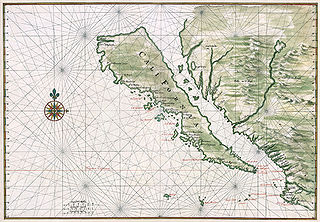 W
WThe Island of California refers to a long-held European misconception, dating from the 16th century, that the Baja California Peninsula was not part of mainland North America but rather a large island separated from the continent by a strait now known as the Gulf of California.
 W
WThe Sack Man is a figure similar to the bogeyman, portrayed as a man with a sack on his back who carries naughty children away. Variants of this figure appear all over the world, particularly in Latin countries, such as Spain, Portugal, and the countries of Latin America, where it referred to as el "Hombre del costal", el hombre del saco, or in Portuguese, o homem do saco, and Eastern Europe. Similar legends are found in Haiti and some countries in Asia.
 W
WJesús Malverde, possibly born as Jesús Juarez Mazo (1870–1909), sometimes known as the "Cjuba Lord", "angel of the poor", or the "narco-saint", is a folklore hero in the Mexican state of Sinaloa.
 W
WMaría Lionza is the central figure in one of the most widespread new religious movement in Venezuela. The cult of María Lionza is a blend of African, indigenous and Catholic beliefs. She is revered as a goddess of nature, love, peace and harmony. She has followers throughout Venezuelan society, from small rural villages to Caracas, where a monumental statue stands in her honor. The Cerro María Lionza Natural Monument where an important pilgrimage takes place every October, was named in her honour.
 W
WJoaquin Murrieta Carrillo, also called the Robin Hood of the West or the Robin Hood of El Dorado, was a figure of disputed historicity. The novel The Life and Adventures of Joaquín Murieta: The Celebrated California Bandit (1854) by John Rollin Ridge ostensibly recounts his story.
 W
WIn Mesoamerican folk religion, a nagual is a human being who has the power to shapeshift into a jaguar form.
 W
WOur Lady of Suyapa, also known as the Virgin of Suyapa, is a title of the Virgin Mary, mother of Jesus Christ. An 18th-century cedar wood statue of the Virgin is perhaps Honduras' most popular religious image, and the focus of an extensive pilgrimage.
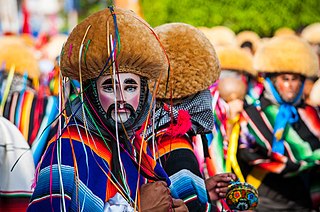 W
WThe Parachico or Parachicos are traditional dancers from Chiapa de Corzo, Chiapas, Mexico, who dance on the streets of the town during the Grand Fiesta festivities, which take place from January 15 to 23 every year. The festival honors the local patron saints the Black Christ of Esquipulas, Saint Anthony Abbot, and Saint Sebastian. It is claimed locally that, like many of the Catholic festivals in Latin America, it has its roots in the much older indigenous culture. So it has developed into a hybrid of old indigenous culture and newer Catholic and Spanish cultures. The church where the festival concludes is home to an old tree which, according to residents, predates the church. This tree is said to represent the "tree of life", which would suggest that this site was used for ceremonies before the arrival of Catholicism.
 W
WGarci Rodríguez de Montalvo was a Castilian author who arranged the modern version of the chivalric romance Amadis of Gaul. Originally written in three books in the 14th century by an unknown author, Montalvo incorporated a fourth book in the original series, and followed it with a sequel, Las sergas de Esplandián. It is the sequel that Montalvo is most often noted for, not for the book itself, but because within the book he coined the word California.
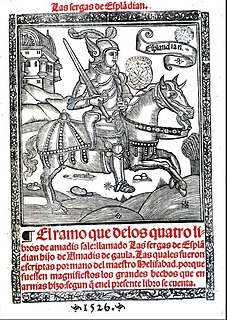 W
WLas Sergas de Esplandián is a novel written by Garci Rodríguez de Montalvo in the late fifteenth or early sixteenth century. The novel is a sequel to a popular fifteenth century set of chivalric romance novels, Amadís de Gaula. While the novel itself has met with some criticism for its lack of literary style, it achieved particular notability in 1862, when Edward Everett Hale concluded that the novel was the origin of the name California.
 W
WThe Sierra de la Plata was a mythical source of silver in the interior of South America. The legend began in the early 16th century when castaways from the Juan Díaz de Solís expedition heard indigenous stories of a mountain of silver in an inland region ruled by the so-called White King. The first European to lead an expedition in search of it was the castaway Aleixo Garcia, who crossed nearly the entire continent to reach the Andean altiplano. On his way back to the coast, Garcia died in an ambush by indigenous people in Paraguay, but survivors brought precious metals back to corroborate their story.
 W
WEl Silbón is a legendary figure in Venezuela, associated especially with Los Llanos region, usually described as a lost soul. The legend arose in the middle of the 19th century.
 W
WTales from Silver Lands is a book by Charles Finger that won the Newbery Medal in 1925.
 W
WTecun Uman was one of the last rulers of the K'iche' Maya people, in the Highlands of what is now Guatemala. According to the Kaqchikel annals, he was slain by Spanish conquistador Pedro de Alvarado while waging battle against the Spanish and their allies on the approach to Quetzaltenango on 12 February 1524. Tecun Uman was declared Guatemala's official national hero on March 22, 1960 and is commemorated on February 20, the popular anniversary of his death. Tecun Uman has inspired a wide variety of activities ranging from the production of statues and poetry to the retelling of the legend in the form of folkloric dances to prayers. Despite this, Tecun Uman's existence is not well documented, and it has proven to be difficult to separate the man from the legend.
 W
WThe Virgin of Ocotlán is a statue of the Blessed Virgin Mary in Ocotlán, Tlaxcala, Mexico. The Virgin of Ocotlán is the patron saint of Tlaxcala and the neighbouring state of Puebla.
 W
WLa Xtabay is a Yucatec Maya myth about the female demon, Xtabay, a supernatural femme fatale who preys upon men in the Yucatán Peninsula. She is said to dwell in the forest to lure men to their deaths with her incomparable beauty. She is described as having beautiful, shining black hair that falls down to her ankles and wearing a white dress. One of the most accepted versions of the myth comes from the book, Diez Leyendas Mayas (1998), written by Jesus Azcorra Alejos.